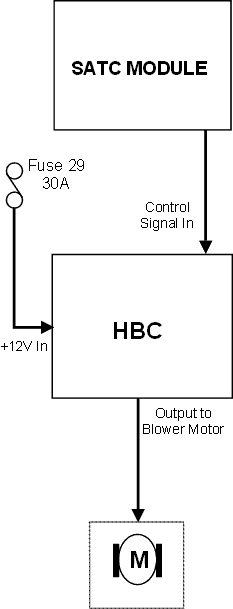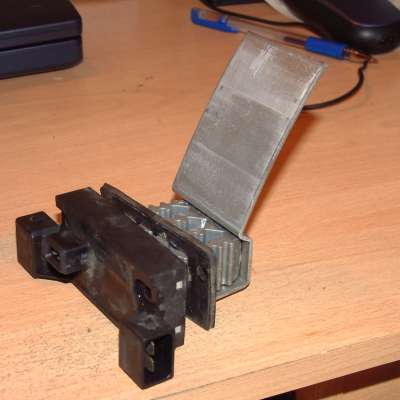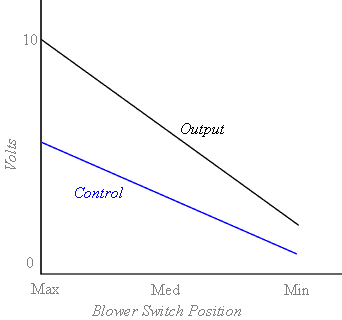System Description
The models of Scorpio equipped with Climate Control, named as Semi Automatic
Temperature Control System (SATC) by Ford, utilise an electronic variable speed
control, or Heater Blower Control (HBC). This speed control causes the speed of
the Blower Motor to be variable. (The HBC is a linear voltage control device and
not a PWM design).
The SATC module provides a control voltage to the HBC, this controls the speed
of the motor. The HBC has a +12V supply.


Testing
Turn the Fan Control switch on the SATC panel to maximum and switch the
ignition to On. The engine does not need to run.
The fan should run at maximum speed. Turn off the ignition and remove connector
to the BLACK/RED & VIOLET/ORANGE wires. Turn back on the ignition and a nominal
10V should be measurable across the connector (HBC Side, not Loom side).
Turn the Fan Control Switch to mid way, the output should be around 5V.
Lastly turn the position to Minimum, the output should be around 3V.
These voltages will vary from component to component and accuracy is not
important, however a reduction in output voltage for a reduction in speed
setting should be shown.
If the fan is on all the time, even with the SATC off, remove the connector to
the WHITE/BLUE & BROWN/BLUE wires, if the fan remains on the HBC is faulty.
If the fan refuses to run and no voltage is measured at the output, check Fuse
F29 in the Main Fuse Box. If this is OK then the HBC or the SATC module may be
faulty - check the fault codes here
To prove the SATC panel is OK a nominal 5V should be measured on the control
input to the HBC (WHITE/BLUE & BROWN/BLUE: not HBC side but Loom Side) for
Maximum and around 1.7V for Minimum.
Note the fault codes generated by SATC may not always be an accurate
representation of the fault. A faulty HBC that fails 'on' all time may not be
shown as an HBC fault but rather it may show as a SATC module fault.
A known problem with early models is a thermal run away effect. In high ambient
conditions the HBC overheats and shuts down. This is usually noticeable as the
Blower will go on and off as it heats up and cools down. To prove this set the
fan to maximum position and observe the behaviour over a period of time - if the
fan slows or stops and later restarts then it is indicative of an overheating
HBC. It may be possible to add additional heatsink or replace it with a later
part.

An HBC removed from the car


![]()
